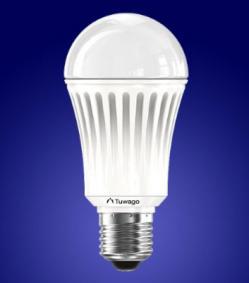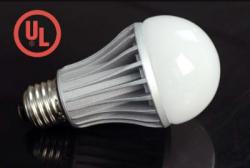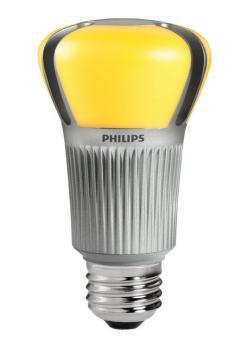Last year I visited Switch Lighting, a small Silicon Valley company that claimed to have built something revolutionary. Switch’s product: a light bulb that produced the same warm, comforting glow that we associate with Edison’s enduring incandescent bulb but lasts 20 times longer and uses a fraction of the energy. It was beautiful, too. A pear-shaped glass orb that sat atop a shiny metallic heatsink, the Switch bulb looked like a work of art. Best of all, it was remarkably affordable. The Switch bulb was going to cost $20, but over its 20-year-lifespan—yes, 20 years!—it would save you almost $100 in energy over an incandescent bulb.
I was won over. In my story—“The World’s Greatest Light Bulb”—I promised that when the Switch bulbs went on sale in the fall of 2011, I’d be buying them for my house. I wasn’t the only one who was thrilled by the prospect of a perfect light bulb. Wired put the same Switch bulb that I’d hailed on its cover. There was only tiny problem with the bulb that Wired and I went gaga for: It was never released. The company says that it ran into unforeseen manufacturing challenges, and late last year it had to go back to the drawing board. The firm completely redesigned the bulb with an eye to making it easier to manufacture. The good news is that the newly designed Switch bulb is now on sale. You can pick one up at a Batteries Plus store near you.
The bad news is that the Switch isn’t the perfect bulb. For one thing, rather than $20, a Switch bulb that’s equivalent to a 60-watt incandescent now costs $50. What’s more, in my testing, the Switch bulb’s glow doesn’t quite match the quality of light put out by an incandescent bulb. And it’s not just Switch: Over the last few days, I’ve been testing four different LED light bulbs that are now available for sale. I found them all to be pretty good, but each was one notch short of perfect. Considering that you’ll be spending a lot of money on these bulbs and using them until around the time Malia Obama runs for president, you’d be wise to hold off buying any LED bulb right now. Next year, they’ll be much closer to perfect.
The lighting industry has been trying to come up with an energy-efficient replacement for the incandescent bulb for a long time now. The pursuit has lately become more urgent, since federal energy regulations are scheduled to limit the sales of old-school bulbs. In October, 100-watt incandescents were banned. Seventy-five-watt bulbs are scheduled to be discontinued next year, and 60-watt bulbs, which comprise the bulk of the home market, will be banned in 2014.
At the moment, the main alternative to the incandescent is the compact fluorescent, but lots of people don’t like these bulbs. I’m one of them. Most CFLs are ugly, contain trace amounts of mercury, and put out a harsh, whitish light that feels clinical. Hordes of CFL-loving readers attacked my stance on these bulbs, pointing out that “covered” CFLs look just as good as regular bulbs, and also produce warm, yellow light. Indeed, in scientific tests, some CFLs have been shown to produce light that people like more than incandescents. Alas, I still blanch at the sight of CFLs—but if you don’t, your perfect bulb is already here.

Courtesy Tuwago/Amazon.
For the rest of us, the best hope for matching incandescent bulbs is with LEDs, which are semiconductors that produce light. The quest to turn LEDs into the perfect bulb has dominated the lighting industry over the last few years.
So what’s wrong with the Switch and other LED bulbs now? Let me explain what I was looking for in the bulbs I tested. First, I wanted a nice “color”—I was looking for a bulb that produced a yellowish light rather than a whitish light. The LED bulbs I tested all aimed to produce a “color temperature” of 2700 kelvin, which corresponds to a “soft white” incandescent bulb. (The higher the color temperature, the “cooler,” or whiter, the light looks.) I was also looking for a bulb that produced a beam that was comparable to that of an incandescent. Placed beneath a lampshade, I wanted the bulb to emit light in all directions (rather than just upward or downward). I also didn’t want the light beam to create sharp patterns on the ceiling or the floor, as a spotlight would—instead, the light should hit objects gently, with a blurry line between light and dark. Finally, I assessed the bulb’s appearance when it was both on and off. I wanted a bulb that would look stylish in a transparent fixture—something you’d be happy to show off rather than hide, as you’d do with a CFL.
My assessment was subjective—I didn’t use a chroma meter to test brightness or color, just my eyes—but I did aim for rigor. I tried a parade of these bulbs in lamps in my bedroom, both one at a time and side-by-side, and I took detailed notes on how they performed. I also enlisted my wife to grade the bulbs on all of these criteria. For good measure, we compared the LEDs to a 60-watt equivalent CFL and a good old 60-watt GE incandescent.

Courtesy HitLights/Amazon.
My least favorite LED bulbs were the two cheapest ones—the HitLights Warm White Globe, which sells for $18, and the Tuwago A19, which goes for $20. Like all the LED bulbs I tested, these were dimmable and turned on instantly. (This is a big advantage LEDs have over CFLs, many of which take a second to turn on and can’t be dimmed.) Both bulbs are well-designed—with a small plastic dome on top of a gently curved base, the HitLights and Tuwago bulbs both look like ice cream cones. What I didn’t like was the quality of their light. I found both to be slightly too white, as white as the CFL bulb in our mix. My wife agreed—she even preferred the CFL to both these LEDs. (To my eye, the CFL looked a bit harsher, but the difference was slight.)
But the worst thing about the HitLights and Tuwago bulbs was their beam direction. Both bulbs primarily shined light upward. This is OK for some uses—it’d be fine in a directional desk lamp and probably not bad in a downward-facing ceiling fixture—but it wouldn’t be ideal for a floor or bedside lamp. If you need a bulb that you can switch to different fixtures, don’t buy one of these.
Next was the $50 Switch bulb. I liked almost everything about this long-awaited product—the light it produced was luxuriously warm and bright, and unlike the cheapest bulbs, it was blessedly omnidirectional. This Switch is also, by far, the prettiest bulb of the lot. Both on and off, it’s a product you want to show off—if you’ve got a lot of dough, buy half a dozen of them and place them in the ceiling of your ultra-modern kitchen. Your fellow rich friends will hate you.
But in addition to its high price, the Switch had one annoying flaw: It produced visible geometric patterns on the ceiling and floor around the lamp. It was the only bulb I tested that produced these patterns, which look like a bunch of overlapping squares and rectangles, and I found them very off-putting—the pattern seemed more appropriate to a showroom than a living room. My wife was so turned off by these shapes that she rated the Switch dead last of all the bulbs we tried; I didn’t like the patterns, but I still thought the Switch rated better than CFL and the two cheaper LEDs.
When I asked the company about these patterns, Gary Rosenfield, the firm’s vice president of marketing, explained that they were an artifact of the specific version of the Switch bulb I was testing. My version has a clear glass dome, which is supposed to produce crisp light patterns, and is best for use in “bare bulb” fixtures indoors and in some outdoor applications. The Switch bulb is the only LED bulb on the market to offer this clear-glass dome. But the company also makes a bulb with a frosted dome that helps to diffuse its light. The company says that version, which I did not try out, doesn’t produce the annoying shapes I saw.
Finally, there’s the Philips AmbientLED bulb, which goes for just over $20. Both my wife and I really liked this one. We found its light to be bright, warm, omnidirectional, and free of any spotlight-like shapes. It’s also reasonably priced. To my wife, the Philips was the perfect bulb—she rated it higher than all other bulbs including the CFL and the incandescent. But I had a problem with the Philips: It’s kind of ugly when it’s turned off. Though it produces white light, the Philips has three mustard-yellow plastic panels on its face. My wife thought it was cute, like a cartoon version of a bulb. I thought it resembled a bug’s eye; it seemed more alien than modern to me, and I wouldn’t want to place it in a fixture where the bulb’s visible.

Courtesy Philips/Amazon.
Obviously, this is my own personal take. If you like how the Philips looks, there’s no reason not to make it your next bulb. It’s cheap and works really well.
But you won’t lose anything by waiting to buy a slate of LED bulbs. That’s because it’s likely they’ll come down in price next year. Tracy Bilbrough, Switch’s CEO, tells me the firm is working on a new bulb that’s easier to manufacture at large scale; it should come out next year and will likely be cheaper than today’s model. Meanwhile Kevin Hou, the CEO of Tuwago, told me that his next bulb, scheduled to be released sometime during the next couple months, will be omnidirectional. Hou wouldn’t tell me how much it will cost, but he did say that it’s reasonable to assume that all LED bulbs will get slightly cheaper over the next year, as manufacturing expands. Bilbrough, of Switch, agreed—if today’s LED bulbs range from $20 to $50, he said, we can expect them to be about $15 to $45 next year.
Those promises—and yes, I’ve been burned by promises from LED manufacturers before—are enough for me to wait. The standard 60-watt bulb will go off the shelves in January 2014. Just before then, I’m hoping LED bulbs will be good enough and cheap enough to rank as credible alternatives. You can replace all your bulbs then—and then never think about them again for 20 years.
